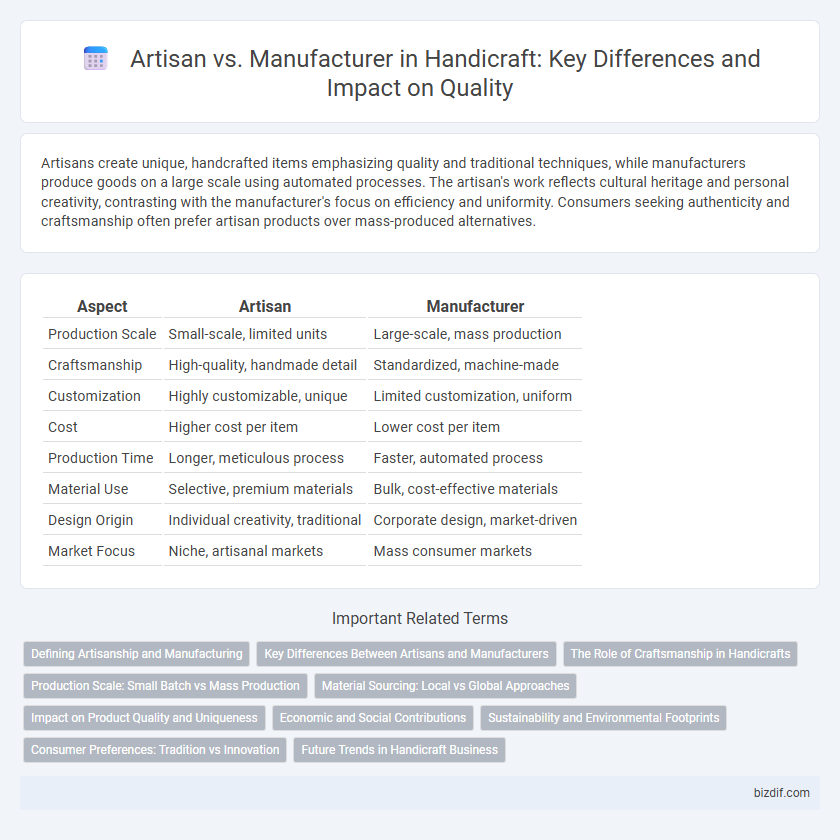Artisans create unique, handcrafted items emphasizing quality and traditional techniques, while manufacturers produce goods on a large scale using automated processes. The artisan's work reflects cultural heritage and personal creativity, contrasting with the manufacturer's focus on efficiency and uniformity. Consumers seeking authenticity and craftsmanship often prefer artisan products over mass-produced alternatives.
Table of Comparison
| Aspect | Artisan | Manufacturer |
|---|---|---|
| Production Scale | Small-scale, limited units | Large-scale, mass production |
| Craftsmanship | High-quality, handmade detail | Standardized, machine-made |
| Customization | Highly customizable, unique | Limited customization, uniform |
| Cost | Higher cost per item | Lower cost per item |
| Production Time | Longer, meticulous process | Faster, automated process |
| Material Use | Selective, premium materials | Bulk, cost-effective materials |
| Design Origin | Individual creativity, traditional | Corporate design, market-driven |
| Market Focus | Niche, artisanal markets | Mass consumer markets |
Defining Artisanship and Manufacturing
Artisanship involves skillful, handcrafted production emphasizing individuality, creativity, and traditional techniques, often resulting in unique, high-quality items. Manufacturing focuses on mass production using machinery and standardized processes to achieve efficiency, uniformity, and large-scale output. The distinction lies in the personalized, labor-intensive nature of artisanship versus the automated, high-volume capacity of manufacturing.
Key Differences Between Artisans and Manufacturers
Artisans create unique, handcrafted products with a focus on quality and individuality, often using traditional techniques and natural materials, whereas manufacturers rely on industrial processes to produce large quantities of standardized goods efficiently. Artisans prioritize creativity and craftsmanship, resulting in limited availability and higher prices, while manufacturers emphasize mass production, consistency, and cost-effectiveness. The key difference lies in the personalized, skill-intensive nature of artisan work compared to the mechanized, volume-driven approach of manufacturing.
The Role of Craftsmanship in Handicrafts
Artisan craftsmanship in handicrafts emphasizes unique, detailed, and culturally rich creations, reflecting individual skill and traditional techniques. Manufacturers prioritize mass production, often sacrificing the personalized touch and intricate quality found in handmade products. The role of craftsmanship ensures each piece embodies authenticity, artistic value, and a strong connection to heritage, distinguishing artisan goods from factory-made items.
Production Scale: Small Batch vs Mass Production
Artisans specialize in small batch production, creating unique, high-quality handicrafts with meticulous attention to detail and craftsmanship. Manufacturers operate on a mass production scale, utilizing automated processes to produce large quantities of standardized products efficiently. The scale difference impacts product customization, pricing, and market reach, with artisans catering to niche markets and manufacturers targeting broad consumer demands.
Material Sourcing: Local vs Global Approaches
Artisans prioritize sourcing materials locally to ensure authenticity, support regional economies, and maintain traditional craftsmanship techniques. Manufacturers often rely on global supply chains to access a wider variety of raw materials at lower costs, enabling mass production and scalability. Local sourcing in handicrafts promotes sustainability and cultural preservation, while global approaches enhance efficiency and product diversity.
Impact on Product Quality and Uniqueness
Artisans create products with meticulous attention to detail, ensuring high-quality craftsmanship and unique designs that often reflect cultural heritage. Manufacturers produce goods on a large scale using standardized processes, which can lead to consistent quality but less individuality in each item. The artisan approach typically results in exclusive, one-of-a-kind pieces, whereas manufacturer-produced products prioritize uniformity and mass availability.
Economic and Social Contributions
Artisans contribute significantly to local economies by producing unique handmade goods that preserve cultural heritage and support sustainable livelihoods. Manufacturers drive economic growth through mass production, creating large-scale employment opportunities and enabling widespread distribution of products. Both sectors play vital social roles, with artisans fostering community identity and manufacturers enhancing accessibility and affordability of goods.
Sustainability and Environmental Footprints
Artisans create handcrafted products using local, natural materials, minimizing energy consumption and waste, which significantly reduces their environmental footprint compared to large-scale manufacturers. Manufacturers rely on mass production techniques that often involve non-renewable resources, higher carbon emissions, and greater waste generation. Sustainability in handicrafts is enhanced by artisans' traditional methods that promote recycling, biodegradable materials, and supporting local economies.
Consumer Preferences: Tradition vs Innovation
Consumers often prefer artisans for handicrafts due to their commitment to tradition, unique craftsmanship, and personalized touch reflecting cultural heritage. Manufacturers attract buyers seeking innovation, consistent quality, and modern designs enabled by advanced production techniques. The market shows a dynamic balance where some value authenticity and handmade appeal, while others prioritize efficiency and contemporary aesthetics.
Future Trends in Handicraft Business
Future trends in the handicraft business emphasize a growing demand for artisan-made products due to their unique craftsmanship and sustainable appeal. Manufacturers increasingly integrate technology such as 3D printing and AI to enhance production efficiency while preserving traditional designs. Collaboration between artisans and manufacturers is expected to drive innovation, blending authenticity with scalable market reach.
Artisan vs Manufacturer Infographic

 bizdif.com
bizdif.com